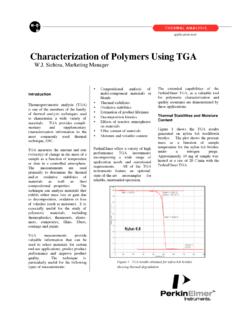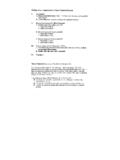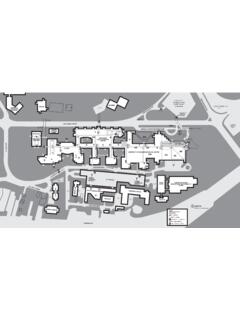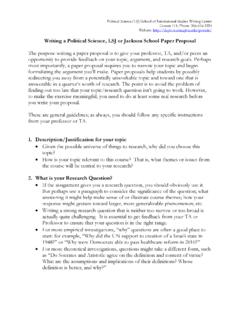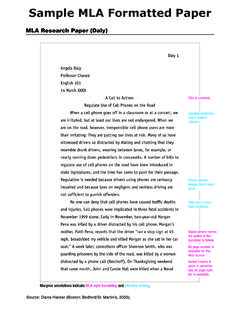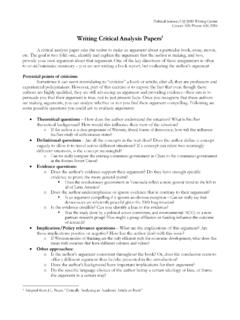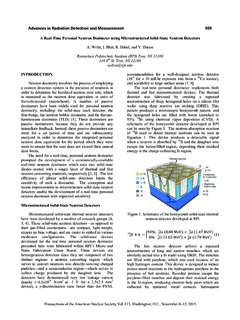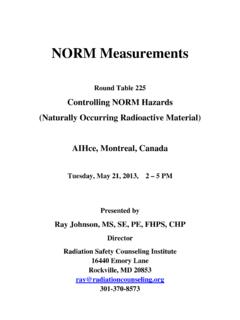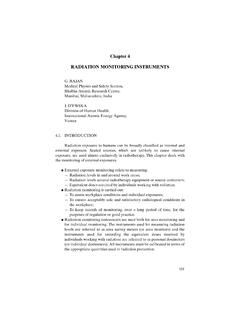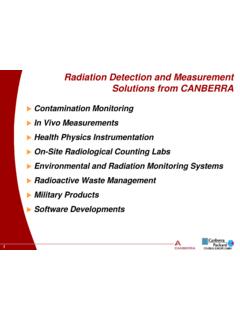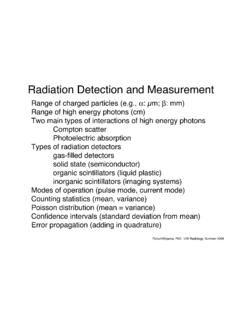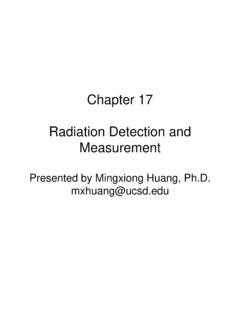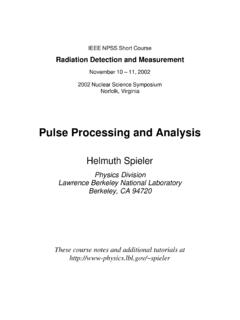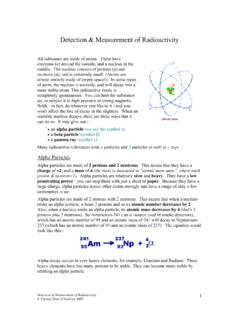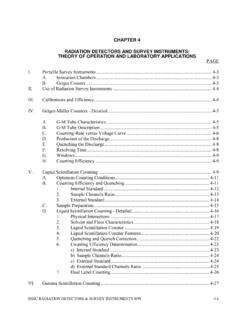Transcription of Radiation Detection and Measurement
1 1 Rad. Detect & Measure, 2008 (TKL) Radiation Detection andMeasurementJune 2008 Tom Detect & Measure, 2008 (TKL)Types of Radiation relevant toNuclear MedicineParticleSymbolMass (MeV/c2) ChargeElectrone-, ! -1 Positrone+, !+ +1 Alpha" 3700 +2 Photon# no rest mass noneRad. Detect & Measure, 2008 (TKL) Loses energy in a more or less continuous slowing downprocess as it travels through matter. The distance it travels (range) depend only upon its initialenergy and its average energy loss rate in the medium. The range for an " particle emitted in tissue is on the orderof m s.
2 " Particle Range in Mattermono-energetic- - - - - - - - - - - - - - - - - - -+ + + + + + + + + + + + + + + + + m s"Rad. Detect & Measure, 2008 (TKL) ! particle ranges vary from one electron to the next, even for !s ofthe same energy in the same material. This is due to different types of scattering events the ! encounters( , scattering events, bremsstrahlung-producing collisions, etc.). The ! range is often given as the maximum distance the mostenergetic ! can travel in the medium. The range for ! particles emitted in tissue is on the order of mm s.! Particle Range in Mattercontinuous energy spectrummm s-!
3 Rad. Detect & Measure, 2008 (TKL)Interactions of Photons with MatterExponential Penetration: N=N0e-$xPhotoelectric effectphoton is absorbedCompton scatteringpart of the energy of the photon is absorbedscattered photon continues on with lower energyPair productionpositron-electron pair is createdrequires photons above MeVCoherent (Rayleigh) scatteringphoton deflected with very little energy lossonly significant at low photon energies (<50 keV)$cm sNN0xRad. Detect & Measure, 2008 (TKL)Basic Radiation Detector SystemPulseorCurrentstoredto diskincoming radiationAnalog-to-digitalAmplify&condit ion2 Rad.
4 Detect & Measure, 2008 (TKL)Basic Radiation Detector SystemsWhat do you want to know about the Radiation ?Energy?Position (where did it come from)?How many / how much?Important properties of Radiation detectors(depends on application)Energy resolutionSpatial resolutionSensitivityCounting SpeedRad. Detect & Measure, 2008 (TKL)Pulse Mode versus Current Mode Pulse mode Detect individual photons Required for NM imaging applications Current mode Measures average rates of photon flux Avoids dead-time lossesRad. Detect & Measure, 2008 (TKL)Interaction Rate and Dead-timeparalyzablenon-paralyzableFrom: The Essential Physics of Medical Imaging (Bushberg, et al)True rateMeasured ratetimedeadtime= recorded eventsRad.
5 Detect & Measure, 2008 (TKL)Types of Radiation Detectorsdetection modes / functionality Counters Number of interactions Pulse mode Spectrometers Number and energy of interactions Pulse mode Dosimeters Net amount of energy deposited Current mode Imaging Systems CT = current mode NM = pulse modeRad. Detect & Measure, 2008 (TKL)Types of Radiation Detectorsphysical composition Gas-filled detectors Solid-state (semiconductor) detectors Organic scintillators (liquid & plastic) Inorganic scintillatorsscintillators operate with aphoto-sensor( another detector)Rad.
6 Detect & Measure, 2008 (TKL)Gas-filled DetectorsIonizing event in airrequires about 34 eVFrom: Physics in Nuclear Medicine (Sorenson and Phelps)3 Rad. Detect & Measure, 2008 (TKL)Gas-filled detectors(operates in three ranges)Geiger-Muller countersProportional countersIonization chambers Radiation survey meters Dosimeters (dose calibrator)From: Radiation Detection and Measurement (Knoll, GF)Rad. Detect & Measure, 2008 (TKL)Ionization ChambersFrom: Physics in Nuclear Medicine (Sorenson and Phelps)ATOMLAB 200 Dose CalibratorNo amplificationNo dead-timeSignal = liberated chargeSettings for different isotopesCalibrationsIonizationchamber regionRad.
7 Detect & Measure, 2008 (TKL)Geiger-Muller countersFrom: Physics in Nuclear Medicine (Sorenson and Phelps)No energy infoLong dead-timeThin window probeRad. Detect & Measure, 2008 (TKL)Semiconductor Detectors Works on same principle as gas-filled detectors( , production of electron-hole pairs insemiconductor material) Only ~3 eV required for ionization (~34 eV, air) Usually needs to be cooled (thermal noise) Usually requires very high purity materials orintroduction of compensating impurities thatdonate electrons to fill electron traps caused byother impuritiesRad.
8 Detect & Measure, 2008 (TKL)Semiconductor Detectors CdZnTe detectors - can operate atroom temperatureRad. Detect & Measure, 2008 (TKL)Organic Liquid Scintillators(liquid scintillator cocktail) Organic solvent - must dissolve scintillator material andradioactive sample Primary scintillator (p-terphenyl and PPO) Secondary solute (wave-shifter) Additives ( , solubilizers) Effective for measuring beta particles ( , H-3, C-14).4 Rad. Detect & Measure, 2008 (TKL)Inorganic Scintillators(physical characteristics)Absorption of Radiation lifts electrons from valence toconduction bandImpurities (activators) create energy levels within theband gap permitting visible light scintillationsRad.
9 Detect & Measure, 2008 (TKL)Inorganic Scintillators(physical characteristics)NaI(Tl)BGOLSO(Ce)GSO(Ce) Density (gm/cm3) Number51756659 AttenuationCoefficient(@ 511 keV, cm-1) Output(photons/Mev)40K~8K~30K~20 KDecay Time230 ns300 ns12 ns60 ns40 nsWavelength410 nm480 nm420 nm430 nmIndex of e sn on on oRuggedn oy e sy e sn osensitivityenergy & spatial speedphoto-sensor matchingmanufacturing / costrelevant detectorpropertyRad. Detect & Measure, 2008 (TKL)Photomultiplier Tube (PMT)From: Physics in Nuclear Medicine (Sorenson and Phelps)photo-sensor needed with scintillatorsRad.
10 Detect & Measure, 2008 (TKL)Sample Spectroscopy SystemHardwareFrom: The Essential Physics of Medical Imaging (Bushberg, et al)incoming high-energy gammarayconverted to1000s of visiblephotons~20%converted toelectronselectron multiplicationbecomes electricsignallarger current orvoltage|more electrons|more scintillationphotons|higher gammaenergy(statisticaluncertainties!)Ra d. Detect & Measure, 2008 (TKL)Interactions of Photons with + with characteristicx-ray scattered photon fromlead x-ray from leadshieldFrom: The Essential Physics of Medical Imaging (Bushberg, et al)Rad.
